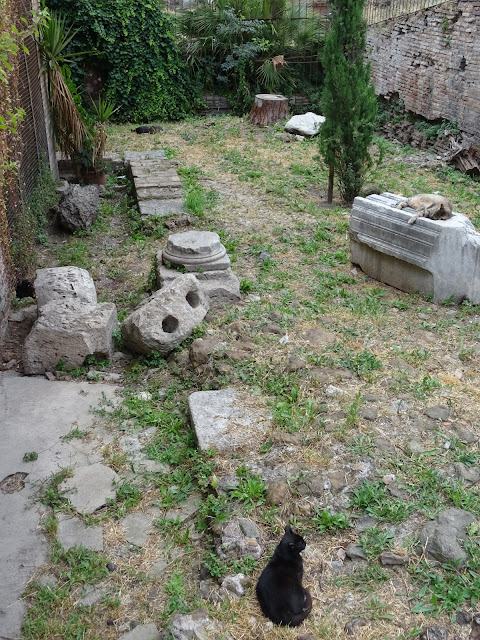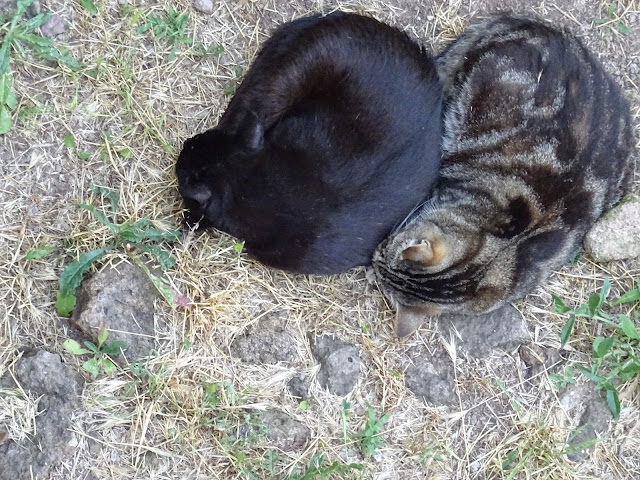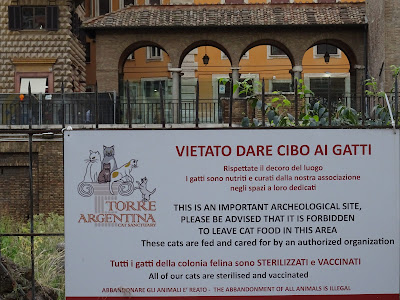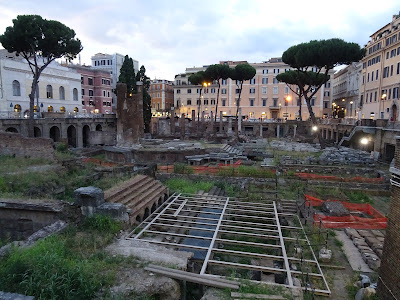 |
| The biggest cat on the block, perhaps we'll call him Caesar, Gaius Julius Caesar |
It appears that
Permaterrailean has taken a long break lasting several months. In fact,
several work/train expeditions (Marseille/Antibes; Freiburg/Basel;
San Daniele/Trieste/Geneva; Venice/Rome/Elba), and much writing,
photographing, and research have occurred between November and today. (I even almost learned to sail, though that's another story.)
So it's more accurate to say that regular publication paused as
the creator continued along life's path, with and without work, with a 2-month-long mid-winter bird flu
virus-version reprise triggering tedious levels of new-old chronic
pain, and with the essential counter measures - exercise and entertainment, family and friends, food and
rest.
In metaphorical gardening/permaculture terms it was a period of analysis, remediating
soil, new design experiments, sowing seeds, transplantating, watering,
chopping and
dropping, adding screeds of mulch, and
intermittently standing back to observe and evaluate the evolution,
all while wending the winding paths. That this has also been literally
occurring in my central-Berlin courtyard garden is incidental.
 |
| Life among the ruins |
The main question now is,
however, how to re-jog your attention to Permaterrailean? How to reflect its new,
seminal, non-linear-time direction? How to spike interest in anything at all in our
information-saturated 21st century? Ok, yes, three questions. With just one obvious 21st century answer: a post teeming with cats.
 |
| Let's call these clannish sleeper buddies Cassius and Brutus |
I’ve stolen the idea from
Largo di Torre Argentina, in central Rome. There, in June, I
accidentally discovered that mixing the homeless cats of the present with (not just) some
old ruins is a clever way to get people looking at the 2000
year-old past.
 |
| It's a sign |
Arriving in the waking city relatively fresh after 24 hours underway from Berlin by train via the always glorious Brenner Pass, capped by taking an Intercity Notte sleeping berth from Venice, I'm looking forward
to a day in Rome before getting aboard a sailing ship, especially after pretty much failing at being a good culture vulture back in September. (https://permaterrailean.blogspot.com/2017/09/september-10-15-headbutting-modern-and.html)
Having lunched and chilled under the trees out in Vitinia at my friend Geraldine's RIPE bnb (https://www.facebook.com/RIPESBB/) till the scorchio part of the day has slid by, I take a quick city train to Porta San Paolo. Circling the Pyramid of Cestius disorients me from my pre-mapped stroll route, and instead, reorienting to moving water, I walk upriver from Ponte Sublicio along the wild, leafy banks of the
Tevere (Tiber) as the summer bars' workers set up for the coming evening.
 |
| You don't always have to follow the map... | | | | | | | | | | |
 |
| ...for you might end up here. Tourists please note the location - point 2 - of the ancient facilities, you never know when you might need 'a moment in peace'. Though this one has been out of order for a while |
Hearing music filtering down from Ponte Sisto cues heading up to rediscover the delights of Trastevere ('beyond the Tiber') and my favourite pizza place in Via del Moro. Thanks to the Romans there's no sign of the ancient Etruscans who once lived round here, though the narrow, pedestrian-friendly alleys are remnants of thousand-year old multi-cultural settlement patterns. Even Julius Caesar had a garden villa in the neighbourhood before he was unceremoniously moved on.
 |
| Cimber prepares for some tunic-pulling action with an aperitivo... |
 |
| ...upon the flagstones |
Sharing a Piazza di Sant'Egidio bronze bench with a reclining bronze homeless Jesus, I survey a couple of machine-gun toting keepers of the peace, who are doing absolutely nothing to cut short the extended mobile phone conversation of a father boring his eleven year old daughter to death. Finally she loses patience, definitively charges down her dad, his phone disappears and they're underway once more. I take their cue and exit too. Or maybe I should say I exire, making a somewhat dodgy third person singular present Latin pun.
 |
| Casca looking daggers |
Piazza Santa Maria lures me and a small throng with sunshine, spritz, and busker pros busting out a stream of Bob Marley hits near the square's fountain, though many of us are driven elsewhere when a democratic pitch-swap changes the soundtrack to equally well-played but less crowd-pleasing jazz. You could say it was a mass exeunt.
 |
| The past awaits rediscovery, at not just another old piazza - Largo di Torre Argentina on the really famous history side of the Tiber river. Undergoing conservation work in 2018, it's studded with Rome's ubiquitous stone pines. Pompey's latrine (left corner) unfortunately somewhat obscured by some old temple |
|
Thus signal my crossing, for the first time in earnest, over Ponte Garibaldi to the other side of the river, to the mega-historical famous monuments zone, a traverse to a kind of hell jammed full of tourists, judging by their multitudes streaming towards me in real-time. Fortunately my original plan is again hijacked, ambushed by yet another piazza, this time, the star of this show, the cat sanctuary piazza, Largo di Torre Argentina. It's a moment I didn't know I'd been waiting for, a serene and beautiful moment of random fortune in my Roman day.
 |
| Pompey surveys his domain... |
 |
| ...with an aspect out to what remains of the temple dedicated to 'Fortuna huiusce diei', the goddess of fortune of the present day |
Judging by the again hoard-like number of tourist buses vaguely registering as coming and going in the background, as well as the deepening twilight, I'm waylaid here for quite some time. One friendly white-bibbed tabby who knows I'm a cat whisperer even
allows me a pat. It's a bit like kissing the Pope's ring, but with more
fur and zero religion.
 |
| A raggedy soothsayer peers into the mystical space-time continuum from the viewing platform, sans attention to the Julian calendar |
What starts as a meditation upon cats peaks to sudden excitement when discovering - thanks to the site map - that this is where Julius Caesar was stabbed to death.
 |
| Take a good long look at where it all happened, the central exedra of Pompey's portico, which was being used as the senate house on 15 March, 44 BCE |
|
|
|
 | | | | |
| The adjacent fortune temple's impassive stones, no luck rubbed off them on the day for Caesar either |
 |
The resident cat troupe restages the assassination of Julius Caesar. Top left, Mark Anthony flees the tumult. Due to
Italy's 'no-kill' law for homeless cats, and that all these delightful beasts have been sterilized, no fur actually flies in today's dramatic re-enactment |
According to the historian Eutropius, about 60
men participated in the bloodbath, collectively landing - by some
magical mathematics - a total of 23 stabs; while according to the historian Suetonius, just one - to the chest - was the lethal blow. That's the kind of justice that assuming excessive power and authority,
creating a nepotistically-appointed, aristocratic ruling class, holding wastefully
extravagant triumphal games, and limiting grain access/reducing the corn dole got you in 44 BCE. Brutal. Leaving the fallen dictator to bleed out on the ground, the conspirators then all ran away, proclaiming freedom for the city.
Regular people weren't impressed. Things fell apart.
 |
| As we see, the pillars of the Roman Republic may have fallen, but present inhabitants happily capitalize on the bloody past |
|
|
|
|
As for me, I cross back over the river to meet Geraldine and her friends for a beer at one of Trastevere's great little pubs, and find myself feeling incredibly happy and satisfied. For quite by happenstance, on June 15, 2018, exactly 2062 years and three months after Julius Caesar's death, my studies - decades before - of Latin, Shakespeare and history, have all come vividly to life in a single day. You just never know when you'll reap what you've sown.